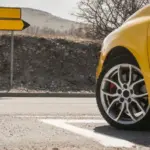Where Is Brake Fluid Located?
Ah, brake fluid! That mysterious concoction that somehow, magically, makes your car stop when you hit the brakes. It’s like the unsung hero of your daily commute, saving you from fender benders and ensuring that your stop at the red light isn’t more dramatic than necessary. But where exactly does this magical fluid hang out in your car? Buckle up, dear reader, for a slightly humorous, moderately educational journey into the depths of your vehicle!
January 31, 2024
Table of ContentsShow
The Great Brake Fluid Expedition
Setting the Scene: Under the Hood
First things first, let’s pop the hood of your car. Yes, that lever by your knee – give it a tug! Now, you’re staring at the engine bay, which looks like a mini city of metal and wires. Amidst this mechanical metropolis, you’re looking for the brake fluid reservoir. It’s usually a small, somewhat transparent container with a label that boldly states “Brake Fluid” (because car manufacturers lack a sense of mystery).
Identifying the Reservoir: A Mini Quest
Finding the brake fluid reservoir is like finding Waldo in a sea of automotive components. It’s usually located on the driver’s side of the car, towards the back of the engine bay. The reservoir is typically mounted on or near the master cylinder – a component that looks like it’s been lifting weights at the gym.
The Appearance: Judging a Book by Its Cover
The brake fluid reservoir is usually made of plastic and is slightly transparent so you can check the fluid level without opening it. It’s like a little window into the soul of your braking system. The cap is generally labeled with either “DOT 3” or “DOT 4,” which are types of brake fluid – but more on that later.
The Mysteries of Brake Fluid
What’s Inside: A Fluid’s Tale
Now, let’s talk about what’s inside that reservoir. Brake fluid is a type of hydraulic fluid. It works under the principle that liquids can’t be compressed (go ahead, try squeezing water – I’ll wait). When you press the brake pedal, this fluid gets pushed through the brake lines and clamps your brake pads onto the discs, bringing your car to a graceful halt (or a screeching one, if you’re dramatic about it).
Types of Brake Fluid: A Menu of Choices
There are different types of brake fluid, primarily DOT 3, DOT 4, and DOT 5. Think of them as different grades of magical stopping potion. DOT 3 and 4 are glycol-based and have a fondness for absorbing water, while DOT 5 is silicone-based and doesn’t mix with water (it’s the oil to DOT 3 and 4’s water).
Checking and Changing: The DIY Symphony
The Art of Checking Levels: Not Just a Glance
Checking the brake fluid level is easier than convincing a toddler that broccoli is candy. Just look at the side of the reservoir. There are usually “min” and “max” lines. If the fluid is below the “min” line, it’s time to top it off. But, remember, if your brake fluid is consistently low, your car might be subtly hinting at a bigger issue – like a leak or worn brake pads.
Changing the Fluid: Not a Mythical Quest
Changing brake fluid is not as complex as assembling IKEA furniture. It’s generally recommended to change it every 2-3 years, but check your owner’s manual – it’s that book in your glove compartment doubling as a napkin holder. You can do it yourself if you’re feeling adventurous, or let a professional handle it if the thought of tinkering with your car gives you the heebie-jeebies.
Fun Facts and Trivia: Impress Your Friends
Did You Know?
Brake fluid can actually damage your car’s paint. So, if you spill it, your car’s going to look like it got a bad chemical peel.
Party Trick:
Brake fluid boils, but at a much higher temperature than water. It’s a fun fact to throw out at parties – if your parties are as nerdy as mine.
Conclusion: The End of the Road
So, there you have it – your whimsical, slightly educational tour of where brake fluid lives and breathes in your car. Remember, while brake fluid may not be as glamorous as the engine or as cool as the turbocharger, it plays a crucial role in your vehicle’s safety. Treat it with respect, keep it topped up, and your car will stop on a dime – or at least within a few feet of one. Drive safe and remember, don’t mix up your brake fluid with your morning coffee; the results can be… less than optimal.


